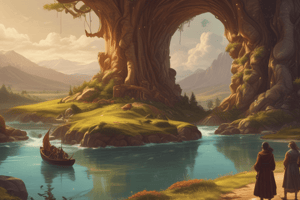Podcast
Questions and Answers
Match the roles of setting with their descriptions:
Match the roles of setting with their descriptions:
Mirror to reflect what's inside the characters = Reveals character's internal state Mold to shape the characters = Influences character development Challenge to test the character = Provides a difficult situation for the character Escape for whimsical expression = Allows character's fantastical side to emerge
Match the functions of setting with their effects on the story:
Match the functions of setting with their effects on the story:
Reveals prevailing atmosphere or mood = Creates a sense of tension or fear Shows internal and external conflicts = Highlights character flaws or disagreements Determines the fate of the protagonist = Influences the story's outcome Reflects character and embodies theme = Illustrates the story's underlying message
Match the aspects of setting with their impacts on the story:
Match the aspects of setting with their impacts on the story:
Physical locale = Shapes the story's mood and atmosphere Context or circumstances = Affects the characters' actions and decisions Time period = Influences the characters' behaviors and values Imaginary or symbolic place = Creates a sense of fantasy or illusion
Match the characteristics of setting with their roles in the story:
Match the characteristics of setting with their roles in the story:
Match the effects of setting changes with their consequences on the story:
Match the effects of setting changes with their consequences on the story:
Match the ways setting influences the story with their effects:
Match the ways setting influences the story with their effects:
Match the aspects of setting with their effects on the characters:
Match the aspects of setting with their effects on the characters:
Match the roles of setting with their impacts on the story:
Match the roles of setting with their impacts on the story:
Match the following types of setting with their descriptions:
Match the following types of setting with their descriptions:
Match the following elements of physical setting with their descriptions:
Match the following elements of physical setting with their descriptions:
Match the following literary devices with their descriptions:
Match the following literary devices with their descriptions:
Match the following authors with their quotes:
Match the following authors with their quotes:
Match the following aspects of setting with their effects on the story:
Match the following aspects of setting with their effects on the story:
Match the following elements of setting with their purposes:
Match the following elements of setting with their purposes:
Match the following geographical setting elements with their description:
Match the following geographical setting elements with their description:
Match the following cultural setting elements with their description:
Match the following cultural setting elements with their description:
Match the following historical setting elements with their description:
Match the following historical setting elements with their description:
Match the following geographical setting elements with their description:
Match the following geographical setting elements with their description:
Match the following cultural setting elements with their description:
Match the following cultural setting elements with their description:
Match the following historical setting elements with their description:
Match the following historical setting elements with their description:
Flashcards are hidden until you start studying
Study Notes
Setting in a Story
- Setting is the physical locale that shapes a story's mood, emotional atmosphere, or quality.
- It is the dramatic backdrop for a story, and can be real or imaginary, concrete or symbolic, a moment or an eternity.
Importance of Setting
- Setting reveals the prevailing atmosphere or mood of a story.
- Changes in the time or place setting can alter the outcome of the story.
- Setting shows internal and external conflicts and highlights potential contrasts between characters or ideas.
- Setting can determine the fate of the protagonist and reflects character, often embodying theme.
Roles of Setting
- Setting can act as a mirror to reflect what is going on inside the characters.
- Setting can shape the characters into who they are.
- Setting can be a challenge, providing a test for the character to reveal their true self.
- Setting can be an alien environment, creating a sense of exile and loss.
- Setting can be an escape, allowing more whimsical and fantastic parts of the character to be expressed.
- Setting can be an antagonist, and an external force may enter the setting and change it, causing conflict for the characters.
Types of Setting
Physical Setting
- Time of day, season, weather, and temperature.
- Indoors or outdoors, type of room or building, objects, colors, and imagery (using the 5 senses).
Geographical Setting
- Location: country, region, province, state, city, neighborhood, street, and floor/level.
Cultural Setting
- Non-physical cultural setting: values, ideals, and attitudes of a place, including education, social standing, economic class, and religious beliefs.
- Physical cultural setting: characters' dialogue, thoughts, statements, and behaviors.
Historical Setting
- Time period, year, reign of a leader, President, role of government, major recent events, transportation, crop yield, epidemics, wars, and natural disasters.
Quote by Eudora Welty
- "Every story would be another story, and unrecognizable if it took up its characters and plot and happened somewhere else...Fiction depends for its life on place. Place is the crossroads of circumstance, the proving ground of, What happened? Who's here? Who's coming?..."
Studying That Suits You
Use AI to generate personalized quizzes and flashcards to suit your learning preferences.




